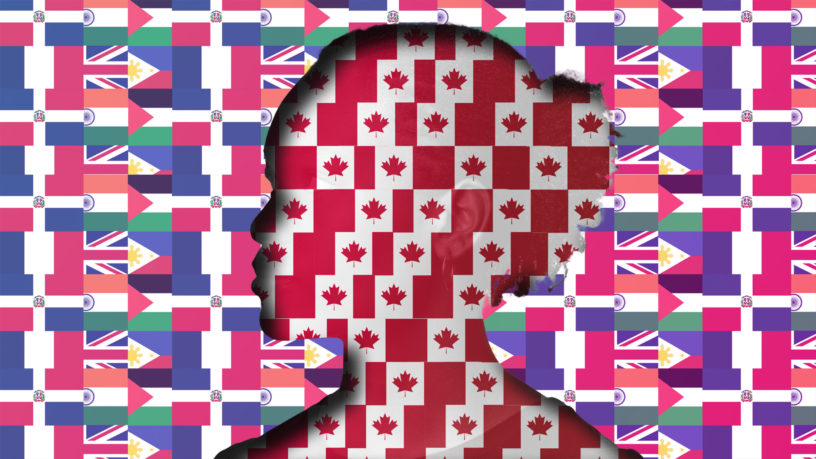
By Fredrick Thomas Reyes
Beyond mere fabric, flags serve as symbols of political ideals, often reflecting the values and embodying the essence of a nation. As they sway gently in the breeze, each flag unfurls a unique story. Each flag represents far more than just a country—it is a seamless construct of tradition and history. The meaning behind these flags is especially profound at Toronto Metropolitan University (TMU), where diversity grows like a blossoming garden.
According to TMU Admissions, the university has over “4,000 international students from over 140 countries,” reflecting the varied cultures that make Canada what it is today.
Within such a vibrant tapestry, it’s important to note the renowned emblem that unifies Canadians across the country—the red maple leaf, prominently seen on the Canadian flag.
According to the Government of Canada’s website, the modern Canadian flag was established in 1965, replacing its predecessor, the Red Ensign. It became the federal flag in 1945 and based on the ensign flown on British merchant ships.
Ronald Stagg, a history professor specializing in Canadian history at TMU said Canada used to fly the Union Jack “because we were a British country.”
“There was a desire in the population for a new flag,” added Stagg. “There was a huge fight over this as then [opposition leader] John Diefenbaker wanted to keep the old flag since he saw [the Canadian Red Ensign] as ‘Canada.’”
As stated on the Government of Canada’s website, the current flag with its red and white colour scheme and singular maple leaf, symbolizes pride and strength throughout Canadian history, and reflects the country’s natural beauty.
Although the maple tree held significance to Indigenous peoples—the Anishinaabe, Abenaki, Haudenosaunee and Mi’kmaq —for its sweet sap, it wasn’t until the 19th century that the maple leaf became widely known as a national symbol.
“Even though you might not find maple leaves in every single part of the country, it is a fairly universal symbol,” said Stagg.
Just as the Canadian flag represents unity, TMU students represent global cultures. From India’s coloured flag to the Philippines’ intricate design, each tells a unique and meaningful story.
Standing among these flags is the Dominican Republic flag. According to Britannica, the flag’s red depicts the blood of heroes, whereas white represents salvation and blue reflects liberty, encapsulating the nation’s history and unwavering strength.
As described in an article by Evangelical Focus, the Dominican coat of arms includes a central white cross with the Bible, a golden cross and an olive branch. This sets them aside as the only country in the world to incorporate the Bible into its national flag, demonstrating its strong commitment to faith.
After decades of French and Spanish rule, the island nation proclaimed independence from its neighbouring country of Haiti in 1844.
Fernanda Oneil, a third-year psychology student at TMU, immigrated to Canada from Santo Domingo, Dominican Republic. Growing up, Oneil recalled her mother and grandmother hoisting the Dominican flag in February to commemorate the country’s independence, expressing that it was a gesture of patriotism that she would pass on to her children.
“No matter [the] good or wrong times…It’s important to remember where you come from,” she said.
Reflecting on her country’s struggle for freedom, she recognizes the values of advocating for her interests and asserting herself to make an impact in the world, echoing the spirit depicted on the Dominican flag. Recognizing that if past generations were able to accomplish such monumental feats, she too can strive for personal empowerment in any aspect of her life.
Unlike in Montreal, she says there aren’t as many Dominicans living in Toronto, so seeing the Dominican flag makes her emotional and brings a rush of pride.
“I cannot lie, I do cry most of the time [when I see my country’s flag],” said Oneil. “When I see it here in Toronto, like on the news [I think], oh, we’ve made it somewhere. We’ve made it this far.”
Among the flags of resilience is the Palestinian flag, embodying hope and strength. With its tricolour of black signifying the Abbasids, white representing the Umayyads and green symbolizing the Fatimids, accented with red, reflects the Palestinian people’s fight for freedom as per an article from Kawa.
According to an article by Reuters, the present-day Palestinian flag was designed by Sharif Hussein for the Arab Revolt, an armed insurrection against the Ottoman Empire in June 1916 and was later re-adopted in 1948.
It’s simple yet powerful design delivers a loud message that words often fail to express. Waving the flag represents the struggle for freedom and hope in the face of adversity, with each flutter symbolizing the enduring tenacity of individuals pursuing independence.
“The Palestinian flag has always been a symbol of unity,” said Jana Alnajjar, a third-year nutrition student and president of the Palestinian Cultural Club at TMU. “At this point, it’s become an international symbol of liberation and wanting justice.”
Palestinians who are unable to raise their flag due to constraints in Palestine, incorporate its colours into traditional clothing such as the thobe says Alnajjar, which features red and black embroidery that are prominently found on the flag.
“It’s very much tied into our clothing, even in food like the colours of a watermelon because they can’t carry the flag and so they use that as a symbol of resistance and hope,” she said.
Alnajjar spoke warmly about her love and pride in being Palestinian, describing how the sight of their flag brings her pride and joy, particularly in a world where her identity is often politicized.
Witnessing someone else carry the Palestinian flag also provides her a great sense of support and security. “It brings me comfort and it’s a sign of liberation,” expressed Alnajjar. “I’ve always been proud of carrying the Palestinian flag.”
Whether waving joyously or standing firm in adversity, flags have a strong bond with their people, signifying shared history and hopes. Beyond their physical appearance, they reflect humanity’s common spirit and serve as compelling reminders of interconnectedness.










Leave a Reply